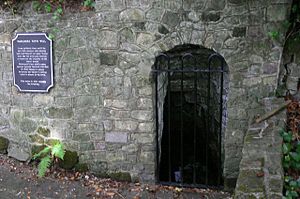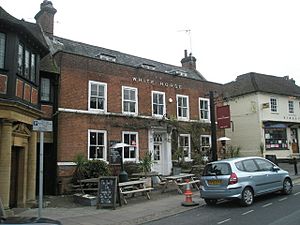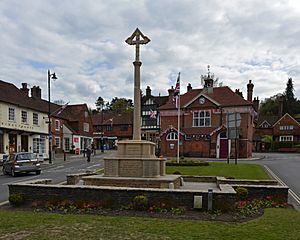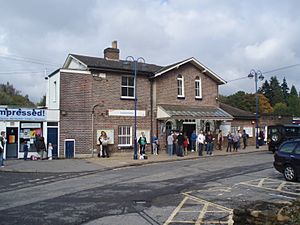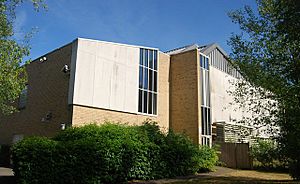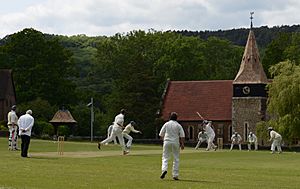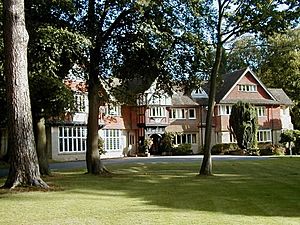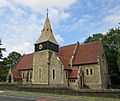Haslemere facts for kids
Quick facts for kids Haslemere |
|
|---|---|
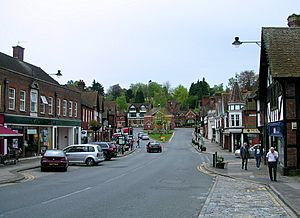 The High Street |
|
| Area | 23.27 km2 (8.98 sq mi) Civil Parish |
| Population | 16,826 (Civil Parish 2011 Census) |
| • Density | 723/km2 (1,870/sq mi) |
| OS grid reference | SU9032 |
| • London | 62 km (39 mi) north east |
| Civil parish |
|
| District | |
| Shire county | |
| Region | |
| Country | England |
| Sovereign state | United Kingdom |
| Post town | Haslemere |
| Postcode district | GU27 |
| Dialling code | 01428 |
| Police | Surrey |
| Fire | Surrey |
| Ambulance | South East Coast |
| EU Parliament | South East England |
| UK Parliament |
|
The town of Haslemere and the villages of Shottermill and Grayswood are in south west Surrey, England, around 39 mi (62 km) south west of London. Together with the settlements of Hindhead and Beacon Hill, they comprise the civil parish of Haslemere in the Borough of Waverley. The tripoint between the counties of Surrey, Hampshire and West Sussex is at the west end of Shottermill.
Much of the civil parish is in the catchment area of the south branch of the River Wey, which rises on Blackdown in West Sussex. The urban areas of Haslemere and Shottermill are concentrated along the valleys of the young river and its tributaries, and many of the local roads are narrow and steep. The National Trust is a major landowner in the civil parish and its properties include Swan Barn Farm. The Surrey Hills Area of Outstanding Natural Beauty is to the north of the town and the South Downs National Park is to the south.
Haslemere is thought to have originated as a planned town in the 12th century and was awarded a market charter in 1221. By the early 16th century, it had become a Parliamentary borough and was represented by two MPs in the House of Commons until 1832. The town began to grow in the second half of the 19th century, following the opening of the London to Portsmouth railway line in 1859. In late-Victorian times, it became a centre for the Arts and Crafts movement and the International Dolmetsch Early Music Festival was founded in 1925. Haslemere became an Urban District in 1913, but under the Local Government Act 1972, its status was reduced to a civil parish with a town council.
Shottermill grew up as a hamlet near to one of the watermills on the River Wey in the 16th century. The settlement began to expand in the 1880s and joined the Haslemere Urban District in 1933. Until the end of the 19th century, Grayswood was a small farming community, but became an ecclesiastical parish in 1901.
Contents
History
The earliest record of Haslemere was in 1221 as a Godalming tithing. The name describes hazel trees standing beside a mere (lake). The lake does not exist today, but there is a natural spring in West Street which could have provided its source. High Street is a watershed with water from the west going to the North Sea via the Wey whilst water from the eastern side goes to the English Channel via the River Arun. In the 14th century Haste Hill, also called East Hill, was the main settlement at Haslemere and there may have been a church as there were references on the site to "Churchliten field" and the "Old church-yard" of Haslemere Haslemere was granted a charter by Richard II in 1394. This right was confirmed by a new charter issued by Elizabeth I in 1596. Today, this special status is celebrated with the Charter fair, held once every two years in the High Street. There is a bust of Elizabeth I in the newly developed Charter Walk, linking West Street with the car park alongside Waitrose.
One of the rotten boroughs, returning two Members of Parliament until the reform Act of 1832, one being Carew Raleigh the son of Sir Walter Raleigh. Haslemere's borough expanded into the surrounding Haslemere parish and recovered with the construction of the Portsmouth Direct Line, which connected Haslemere with London Waterloo and Portsmouth Harbour railway stations. In Victorian Britain Haslemere became a fashionable place to live and continues to be a commuter town for London, and to a lesser extent Portsmouth, served by Haslemere railway station.
During the building of the railway, the first of the two murders of Surrey Police Officers occurred in Haslemere High Street, on the night of 28/29 July 1855, when Inspector William Donaldson was beaten to death by drunken navvies, which brought the darkest hour in the history of Haslemere. The only other murder of a Surrey Police officer was in Caterham some 120 years later.
St Bartholomew's Church was originally a chapel of ease for Chiddingfold, and probably dates from no earlier than the 16th century. It was rebuilt in 1871. The bell tower is the only remaining part of the original building. The church contains memorials to many of the most prominent local residents, including Alfred Lord Tennyson, who lived south of Haslemere at Aldworth House and is commemorated in one of the stained glass windows, featuring Sir Galahad and the Holy Grail.
Geography
Haslemere is a town in the borough of Waverley, Surrey, England, close to the border with both Hampshire and West Sussex and is the most southerly town in Surrey. The major road between London and Portsmouth, the A3 lies to the west and a branch of the River Wey to the south. Haslemere is 11.9 miles (19.2 km) southwest-by-south of Guildford. surrounded by hills, with Blackdown at 920 feet (280 m) to the south and Gibbet Hill at 894 feet (272 m) to the north. The latter was the site of state executions from at least medieval times until the late 18th century. Many of those hanged were highwaymen, because the roads around Haslemere, particularly alongside the nearby Devil's Punch Bowl, were notoriously dangerous. Today, much of the heathland and woodland is owned and protected by the National Trust and has become a popular attraction for walkers.
Walks
Haslemere marks the western end of the Greensand Way footpath which extends for 110 miles (180 km) to Hamstreet in Kent via the high Greensand Ridge, and is one end of the short Serpent Trail which connects to the Sussex Border Path.
Elevations and soil
Elevations range between, in fully developed roads, 205m AOD to 97m and 112m AOD alongside respectively the east and west streams which forms an east-west steep valley through the parish almost meeting in the town centre. This lowest point is specifically in the north east, where one headwater gently curves north following the line of the railway past the north of Grayswood, however rapidly descends another 40m in the space of a few miles. This east stream is the longest headwater of the River Arun then passing the north of Chiddingfold and turning south close to in the village centre of Dunsfold. By contrast the west stream, the River Wey south branch flows around Headley and past Frensham Common, joins the north branch in the centre of Tilford and heads towards Guildford before reaching the River Thames. However across the north and the south, the wooded hillsides reach 272m at Gibbet Hill in the north and 204m, AOD 211m on Marley Common south of Camelsdale and 280 on Black Down rising gradually across the county line in West Sussex.
The soil is particularly unusual, though common in southwest Surrey, the Bordon area of Hampshire and bottom of the upper vale of Midhurst, being "freely draining very acid sandy and loamy soil" that forms 1% of English soil, of low fertility; its natural vegetation includes acid grasses, pines and coniferous trees; further examples include Blackheath, Surrey and Blackheath, London.; to the east of Haslemere is the more naturally fertile "slowly permeable seasonally wet slightly acid but base-rich loamy and clayey soil" that here forms the western start of the Low Weald soil that continues as far as Maidstone, Kent.
Localities
Grayswood
Grayswood is a small village to the northeast of Haslemere and 5 miles (8.0 km) southwest of Witley. In 1894, Alfred Hugh Harman moved to Grayswood and in 1900 he offered to finance a church in Grayswood on land given by Lord Derby, on condition that a parish was created. The new ecclesiastical parish of Grayswood was formed from parts of the parishes of Witley, Chiddingfold, Haslemere and Thursley in 1901.
Shottermill
Shottermill is a parish and village 1 mile (1.6 km) to the west of the town. Shotters mill, after which the area is named and Shottermill Ponds are located in the county of West Sussex, the mill being a few yards south of the Wey which forms the county boundary. The mill was driven by piped water from the ponds. Weyhill is a busy shop-lined street linking the railway station to Shottermill. Weyhill took its name from the old mill at the head of the south branch of the Wey which rises in Haslemere; this area includes 5,769 of Haslemere's 15,612 residents (2001). Novelist George Eliot had a cottage, Brookbank, on what was Shottermill Common, where she wrote most of Middlemarch. Woolmer Hill to the west here is a half developed, half wooded hill, which includes The Edge sports centre with sports ground and Woolmer Hill School which is state-sponsored.
Ten buildings in the village are listed, as well as two on the hillslopes around the hammer ponds in the hamlet known as Critchmere. One of the latter is the Grade II* listed Branksome Place. Dated 1901 over its entrance, it was designed by E J May but has Edwardian additions. It has enormous classroom wings in Glass Reinforced Polyester by James Stirling connected by a corridor at the rear. It was used as an hotel and conference centre until 2012. The modern parts mark a shift in Stirling's career away from the heavy, Brutalist brick aesthetic of his early work to a more classically-inspired post-modern tradition which is international in flavour; here he developed the use of GRP as a sophisticated building material, and this is the first "major building by a major architect to be built in GRP in Britain". The principal spaces are richly designed, and survive virtually unaltered. Extension rooms have a nautical theme as it was previously a naval college.
There are other minor areas of settlement to the south.
Shepherd's Hill
Shepherd's Hill is the name belonging to the neighbourhood to the south of the town centre, which is accessed by three short roads, Shepherd's, College and Museum Hill. The area has large gardens and four listed buildings Broad Dene at Grade II*, features a round tower with conical roof and spike. It was built in 1900 for Walter Tyndale by William Frederick Unsworth, see Shakespeare Memorial Theatre; his business partner being Inigo Triggs. Substantial and sensitive masonry makes up the house, carefully recalling medieval solidity and enclosure.
Nutcombe
This hillside community nestles among the woods leading to Hindhead and consists of approximately forty houses of which three are listed buildings.
Economy, culture and community
Its High Street is wide because of its use as a cattle market before the 1920s and characterises the heart of Haslemere, with the Town Hall standing at its southern end. The White Horse and The Swan Inn are the two public houses along the main street. Along the High Street, West Street and Charter Walk are a mix of shops (mostly independent), restaurants, cafes, banks and estate agents. In 2009 a Waitrose opened in the town centre replacing the previous Somerfield supermarket.
To the west of the High Street, separated from it by the railway station, is an area known as Wey Hill. Here, there is a bank and a public house, shops (again, mostly independent), restaurants and takeaways. The town library is in Wey Hill and so are two further supermarkets, a Tesco and a M&S
Local news is provided weekly by the Haslemere Herald (established 1896) and other publications.
Haslemere Hall
Haslemere has a concert hall known as The Haslemere Hall. Located on Bridge Road, just off West Street, the hall can seat 340 people and is used regularly as a theatre, a concert venue and a cinema. Performances are held by local theatre groups including the Haslemere Thespians and the Haslemere Players. Haslemere Musical Society Symphony Orchestra and Chorus, conducted by James Ross, also hold performances and there are popular music concerts. Films are shown shortly after their general release.
Dolmetsch Early Music Festival
The town is significant musically, partly through the contribution of one family. Arnold Dolmetsch, musician and instrument maker, was born in France in 1858. The family settled in Haslemere his son, Carl Dolmetsch, taking over the business. They revived the recorder and began the revival of other instruments of early music, contemporarily with the start of historically informed performance which itself came to fruition towards the end of the 20th century. The family firm still manufacture viols, recorders and harpsichords. Their presence inspired the International Dolmetsch Early Music Festival held every year in the town.
Haslemere Town Band
Haslemere Town Band was officially founded in 1837 following the amalgamation of two small bands which had started in 1834, and is one of the UK’s oldest brass bands in continuous existence. Their first engagement was playing for the coronation of Queen Victoria in 1838. The Band continues to play an active part in the life of the town, playing at community events throughout the year, as well as at numerous summer fetes and garden parties in the surrounding district. They have also performed in the twinning towns of Bernay in France and Horb am Neckar in Germany.
Haslemere Charter Fair
In 1397 Richard II and the Bishop of Salisbury confirmed an order dated 29 April 1221 allowing an annual fair to be held in the town. The first ever recorded fair was held in the year 1394 and continue yearly, for example 7 May 2012. Although this ceased to be a yearly event some time ago and was reinstated in 1984 and now runs every two years.
Transport
Roads
Many of the roads in the area originated as medieval tracks and owing to the local topography, are narrow, twisting and steep. The principal route through Haslemere is the A286, which connects the town with Godalming and Grayswood (to the north) and with Midhurst (to the south). The A287 runs south from Hindhead and passes through the west end of Shottermill, before joining the A286 close to Camelsdale. The main east–west road is the B2131, which links Haslemere to Chiddingfold and Petworth to the east, and to Liphook to the west.
Buses
Haslemere is linked by a number of bus routes to surrounding towns and villages in south west Surrey, West Sussex and east Hampshire. Operators serving the town include Stagecoach and Waverley Hoppa.
Trains
Haslemere railway station is to the west of the town centre. It is managed by South Western Railway, which operates all services. Trains run to London Waterloo via Guildford and to Portsmouth Harbour via Havant.
Cycling
The Haslemere Link is a spur of the Surrey Cycleway. It runs north east from the town to join the main circular route to the east of Chiddingfold.
Long-distance footpaths
Haslemere is the western terminus of the Greensand Way, a long-distance footpath that runs for 108 miles (174 km) along the Greensand Ridge to Hamstreet in Kent. The 64-mile (103 km) Serpent Trail links Haslemere to Petersfield via Blackdown and Petworth. The Sussex Border Path runs to the south of Haslemere and Shottermill.
Sport
Leisure centres
Haslemere Leisure Centre, on the King's Road, was opened in 1998–99. The construction was funded by the sale of Shottermill Recreation Ground, which had been owned by Waverley Borough Council since 1974. The centre underwent a £3.8M refurbishment 2014–15, which included the upgrade of the fitness gym facilities and the addition of dance and cycling studios. The centre is managed by Places Leisure, on behalf of the Borough Council.
The Edge Leisure Centre is on Woolmer Hill Road. The centre has an indoor dance studio and fitness suite, outdoor pitches for sports including football and rugby, as well as an athletics track. A new artificial hockey pitch was installed at the centre in 2018.
Association Football
Shottermill & Haslemere Football Club was founded in 2001 as an amalgamation of two existing clubs. The club plays its home games at Woolmer Hill Sports Ground and has been a member of the Surrey County Intermediate League (Western) since 2006.
Cricket
Haslemere Cricket Club was founded in 1827 and originally played its home games at a field near the High Street. The club moved to Haste Hill in 1850 and then to Lythe Hill in 1868. Since 1922, the club has played at the recreation ground on Scotland Lane.
Cricket has been played on the village green at Grayswood since the early 20th century and there have been at least three incarnations of the local club. The current Grayswood Cricket Club was reformed in 1989 and has been a member of the I'Anson League since the 1997 season. In 2017, the club were league champions for the third time, having previously won the title in 2012 and 2013.
Hockey
Haslemere Hockey Club was founded in 1946 and plays its home games at Woolmer Hill Sports Ground, which has two AstroTurf pitches.
Rugby
Haslemere Community Rugby Club was founded in 1950 and was initially sponsored by Harlequins. At first, it played its home games at the recreation ground on Scotland Lane, but later moved to its current base at the Woolmer Hill Sports Ground.
Twinning
Haslemere is twinned with Bernay in France and Horb am Neckar in Germany.
Demography and housing
| Output area | Area | Population | Households | Homes owned outright | Homes owned with a loan |
|---|---|---|---|---|---|
| Haslemere East and Grayswood | 9.94 km2 (3.84 sq mi) | 6,553 | 2,766 | 39.7% | 34.4% |
| Haslemere Critchmere and Shottermill | 6.50 km2 (2.51 sq mi) | 5,981 | 2,445 | 29.6% | 40.7% |
| Hindhead and Beacon Hill | 6.82 km2 (2.63 sq mi) | 4,292 | 1,688 | 38.6% | 38.5% |
| Total for Haslemere Civil Parish | 23.27 km2 (8.98 sq mi) | 16,826 | 6,899 | 35.8% | 37.6% |
| Regional average | 35.1% | 32.5% |
| Output area | Detached | Semi-detached | Terraced | Flats and apartments | Caravans, temporary and mobile homes |
|---|---|---|---|---|---|
| Haslemere East and Grayswood | 1,202 | 637 | 454 | 613 | 1 |
| Haslemere Critchmere and Shottermill | 849 | 611 | 398 | 694 | 1 |
| Hindhead and Beacon Hill | 858 | 289 | 121 | 495 | 0 |
| Total for Haslemere Civil Parish | 2,909 | 1,537 | 973 | 1,802 | 2 |
| Regional average | 28% | 27.6% | 22.4 % | 21.2 % | 0.7% |
Education
Maintained schools
St Bartholomew's Primary School was founded as a National school c. 1813. In 1869 a School Board was established in Haslemere, which commissioned the construction of a new building adjacent to the parish church. The school moved to its current site on Derby Road in 1986.
Shottermill Infant School and Shottermill Junior School trace their origins to a Church of England school that was opened in the village c. 1846. Initially there were 40 pupils and only one teacher, but as numbers increased, the school moved to new premises to the north east of Shottermill Church. The building was extended in 1885 and again in 1896–98. In the early 1900s, the infants department became a separate school in its own right and moved to Church Road. In 1927, the county council took over the running of the two schools and constructed new premises for each on Lion Lane.
Grayswood Primary School was founded as a National school in 1862. It moved to its current site, as an infants' school, in January 1905 with 100 pupils. It was expanded in 2015 to become a primary school, educating up to 210 children between the ages of 4 and 11.
Woolmer Hill School is a secondary school to the north west of Shottermill. It was constructed in 1950 on a 10 ha (25-acre) site, under the provisions of the Education Act 1944. It became a member of the Weydon Multi-Academy Trust in 2017. In 2021, it educates around 800 students between the ages of 11 and 16.
Independent schools
St Ives School, to the north east of Haslemere town centre, is a coeducational prep school for children aged 2–11. It was founded in College Hill in 1911 and moved to its current location in Three Gates Lane in 1966. The school became part of United Learning in September 2013.
The Royal School is a coeducational day and boarding school to the north of Shottermill. It was founded in 1840 as the Royal Naval School and was intended to educate the sisters and daughters of naval and marine officers. It merged in 1995 with The Grove School, also a girls-only school, to create The Royal School. In 2011 the school became co-educational and in 2019 it became part of United Learning.
Former schools
Stoatley Rough School was founded in 1934 by Dr Hilde Lion to educate the children of Jewish refugees, who had fled from Nazi Germany. As war approached, the boarding school accepted many children rescued under the Kindertransport scheme. After the end of the war it began to focus on educating disadvantaged British pupils. It closed in 1960, following the retirement of its founder.
Wispers School was an independent girls' boarding school originally founded in 1947. It moved to Oak Hall in 1969 and closed in 2008.
Religious institute
The UK campus of the Islamic university, Jamia Ahmadiyya, was founded in Colliers Wood in 2005 and relocated to Haslemere in 2012. It offers a seven-year course to train missionaries from the Ahmadiyya Muslim Community and educates over 130 students at any one time. The Haslemere campus is a Grade II*-listed former country house, built in 1901, which was the International Education Centre for Olivetti in the early 1970s. Design work for the conversion to an education centre was undertaken by the architects Ted Cullinan and James Stirling and involved the addition of a new classroom wing built from glass-reinforced plastic. In 1997 it became a conference centre, run by the De Vere hotel group, and was acquired by Jamia Ahmadiyya UK in 2012.
Notable people
- John Boxall (d. 1571) — Secretary of State to Mary I, owned Burgage House (now the Haslemere Museum)
- James Oglethorpe (1696—1785) — founded the Colony of Georgia, was MP for Haslemere (1722–1754) and lived at Town House on the High Street
- Josiah Wood Whymper (1813—1903) — artist, lived at Town House, High Street, Haslemere from 1859 until his death
- George Bowdler Buckton (1818—1905) — chemist and entomologist, designed his own house on Weycombe Road, where he lived from 1865
- George Eliot (1819—1880) — novelist and poet, wrote much of Middlemarch while living in Shottermill in the summer of 1871
- Anne Gilchrist (1828—1885) — writer, lived in Shottermill from 1861 to 1871
- John Penfold (1828—1909) — surveyor, architect and designer of a Post Office standard pillar box, lived at what was then called Courts Hill House
- Archibald Geikie (1834—1924) — geologist, retired to Haslemere in 1913
- Axel Haig (1835—1921) — artist, illustrator and architect, designed his own house on Highercombe Road, where he lived from 1865
- Robert Hunter (1844—1913) — co-founder of the National Trust, Chairman of the Haslemere Parish Council, lived at Meadfields Hanger
- William Cecil Marshall (1849—1921) – sportsman, designed his own house on Hindhead Road, where he lived from 1887
- Arnold Dolmetsch (1854—1940) and his son Carl Dolmetsch (1911—1997) — musicians and musical instrument makers, lived in Grayswood Road
- Walter Tyndale (1855—1943) — artist, lived in Haslemere from c. 1890. He commissioned the construction of Broad Dene, Hill Road, in 1900 and lived there until his death.
- Cyril Edward Gourley (1893—1982) — Victoria Cross recipient, lived in Grayswood from 1952 until his death
- Robert Lochner (1904—1956) – inventor of the Bombardon Breakwater, used at Mulberry harbour, Normandy, on D-Day. He lived at Shottermill from 1939 until his death.
- W. H. C. Frend (1916—2005) — ecclesiastical historian, archaeologist, and Anglican priest, was born at Shottermill Vicarage and lived in the village as a child
- Robin Phillips (1940—2015) — actor and director, was born in Haslemere
- Rachel Portman (b. 1960) — composer, was born in Haslemere
Images for kids
See also
 In Spanish: Haslemere para niños
In Spanish: Haslemere para niños



